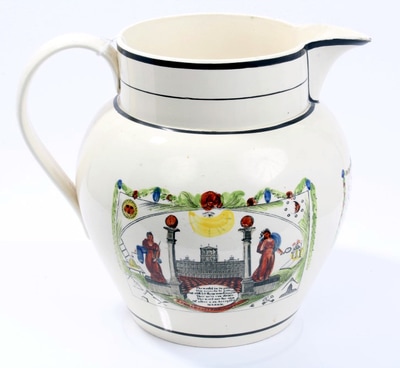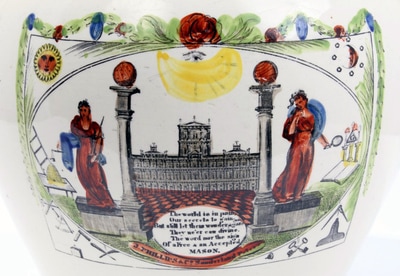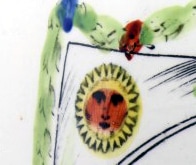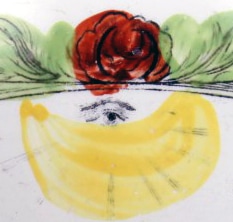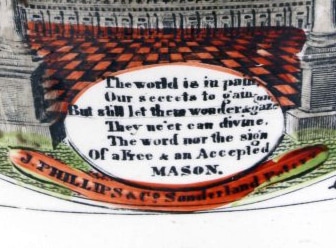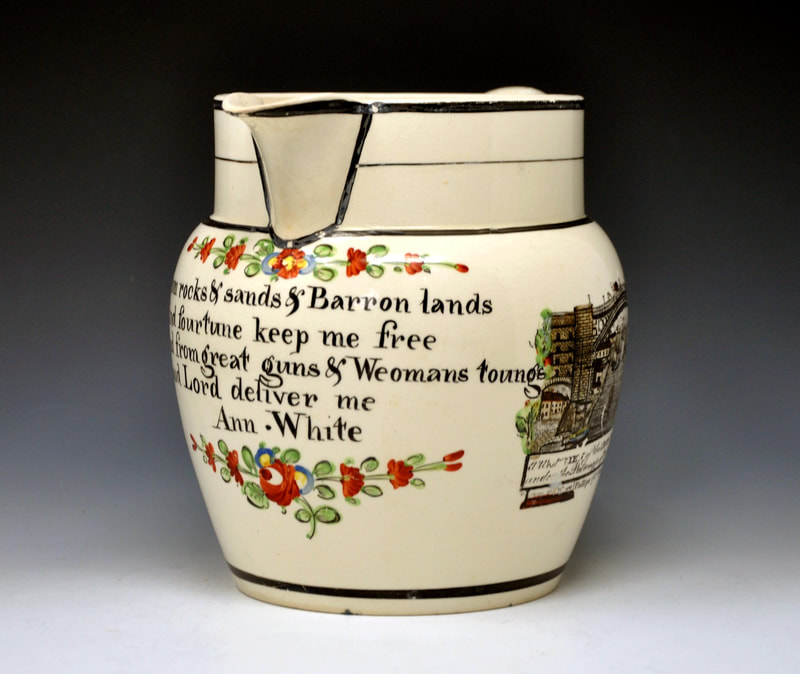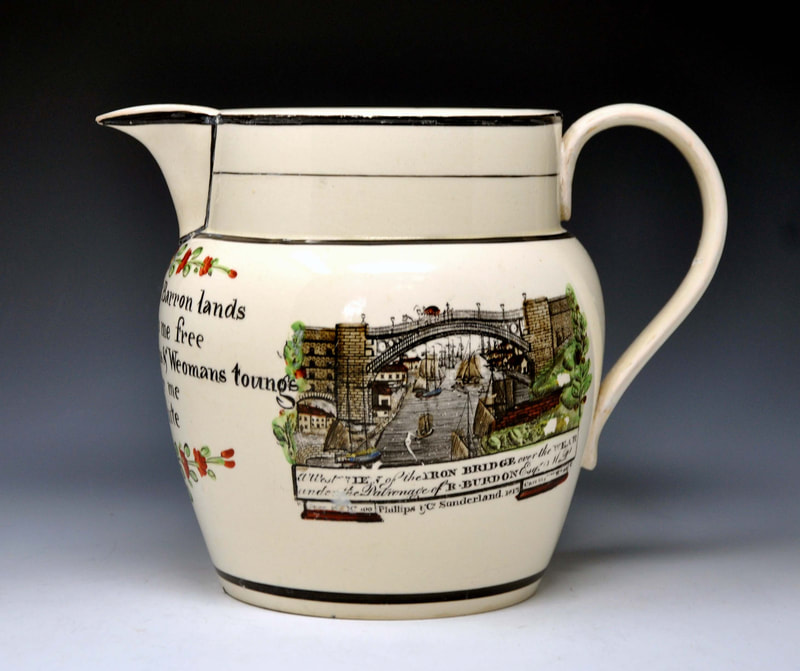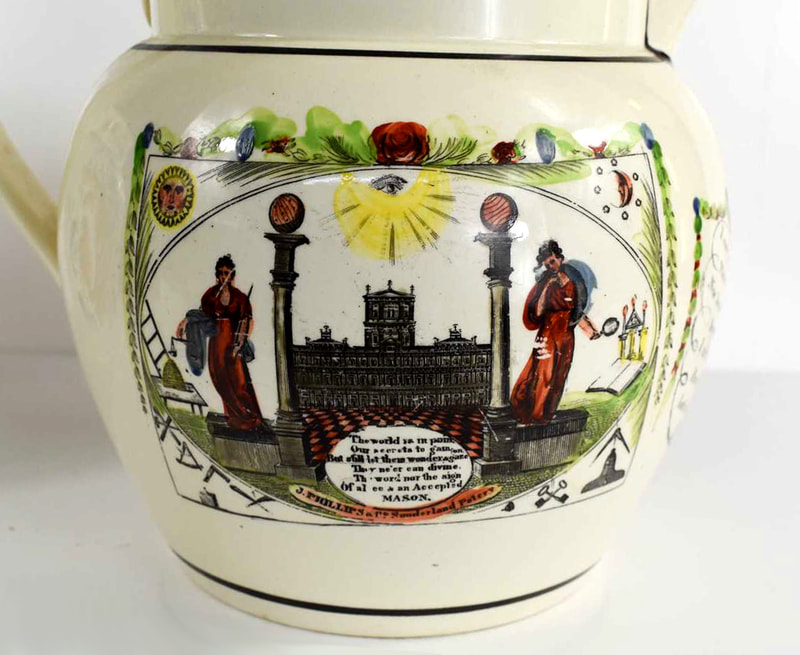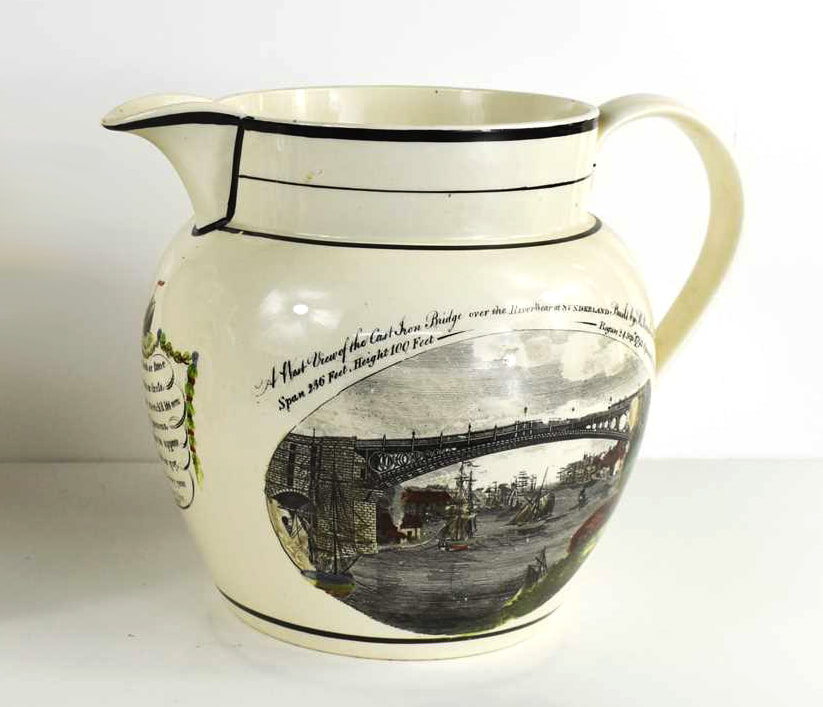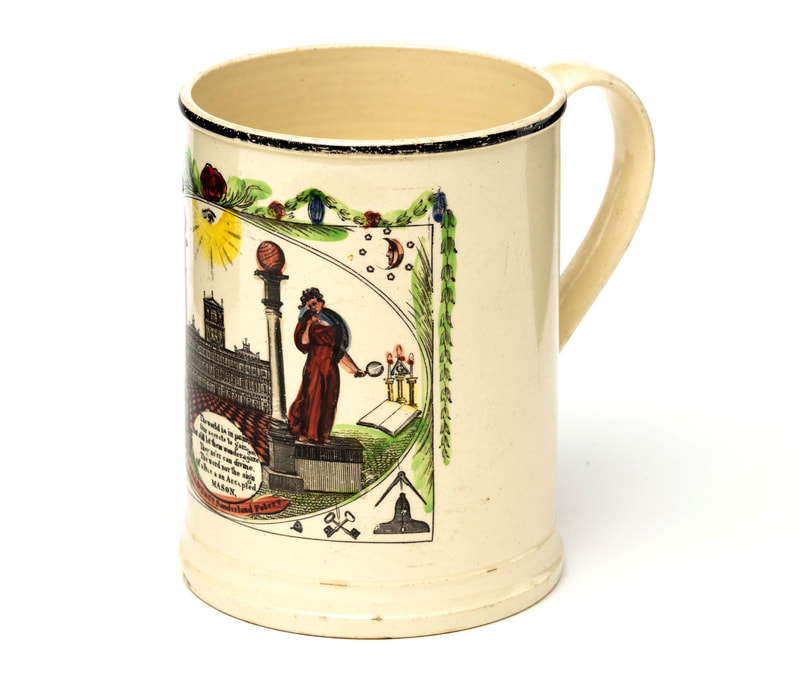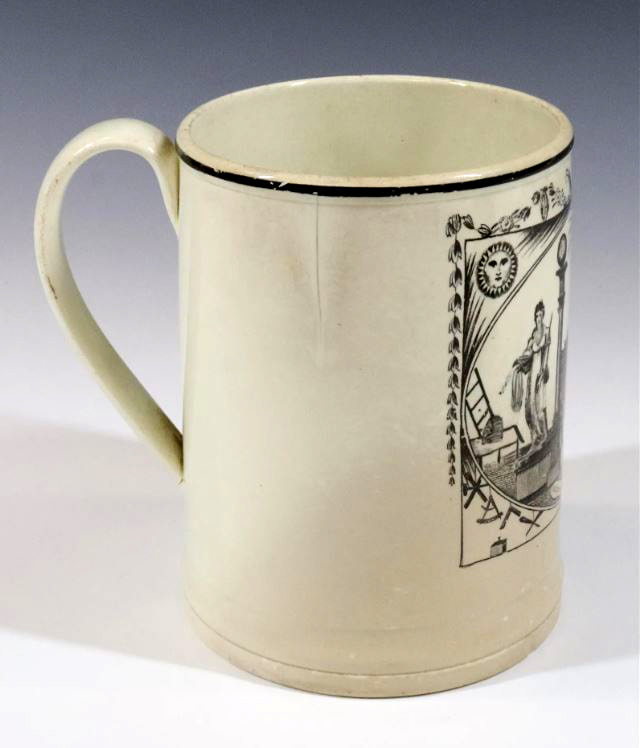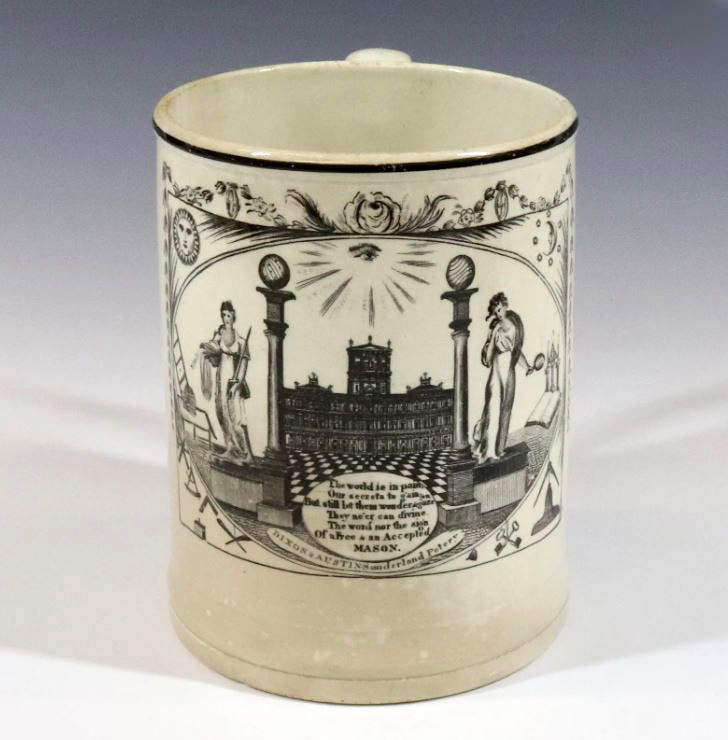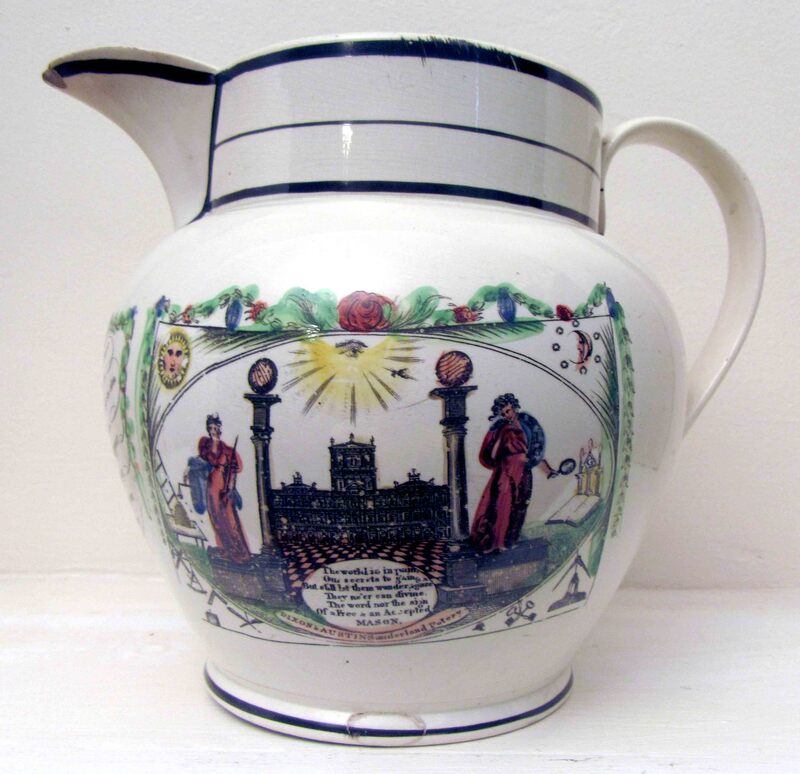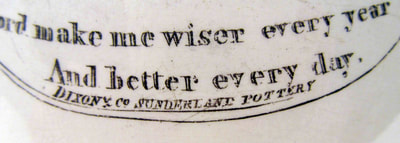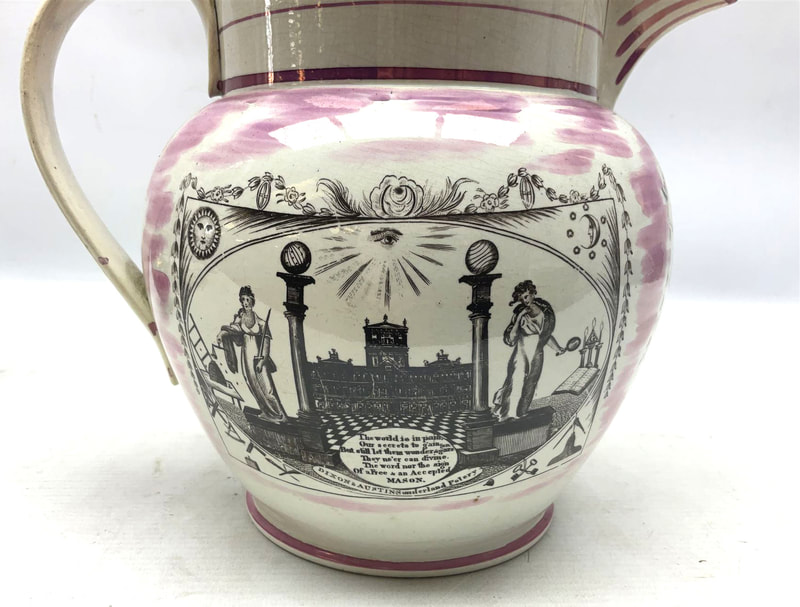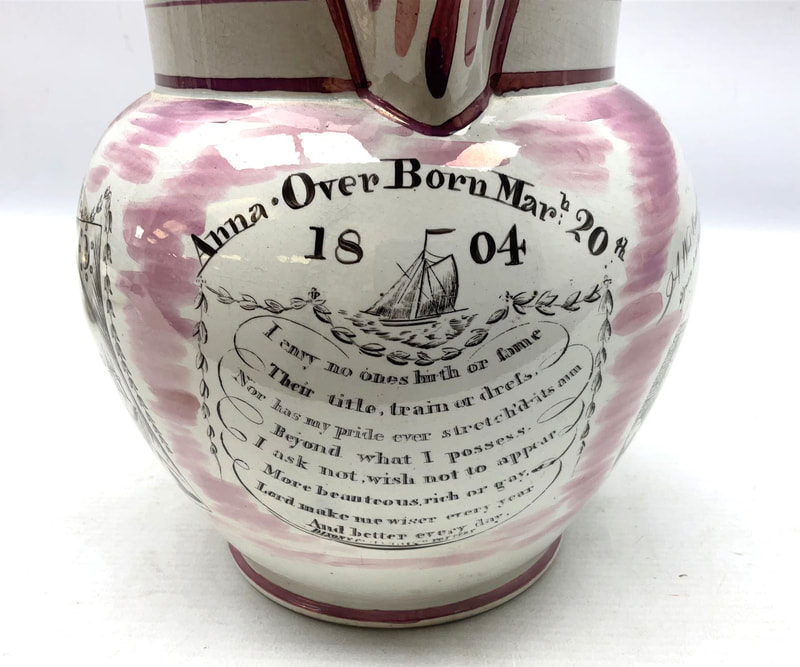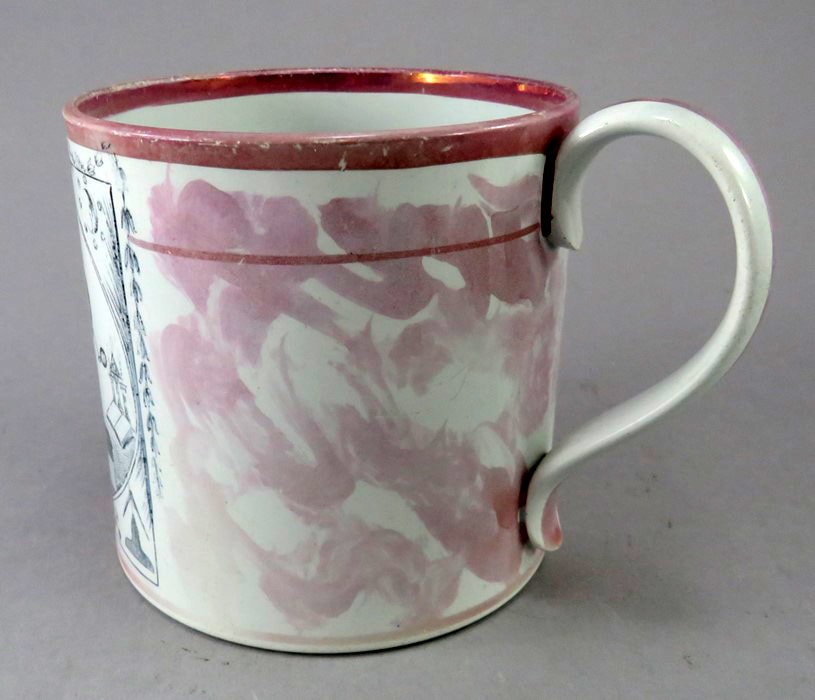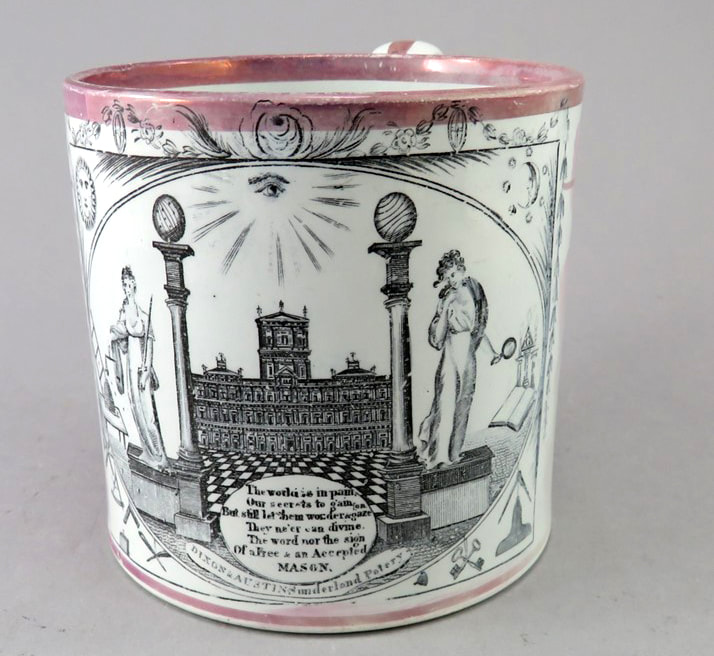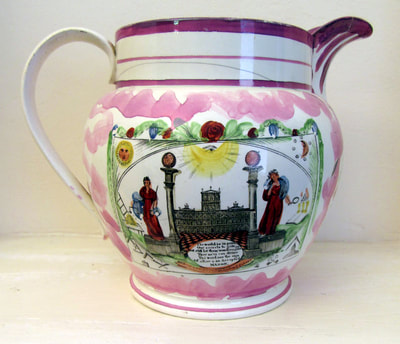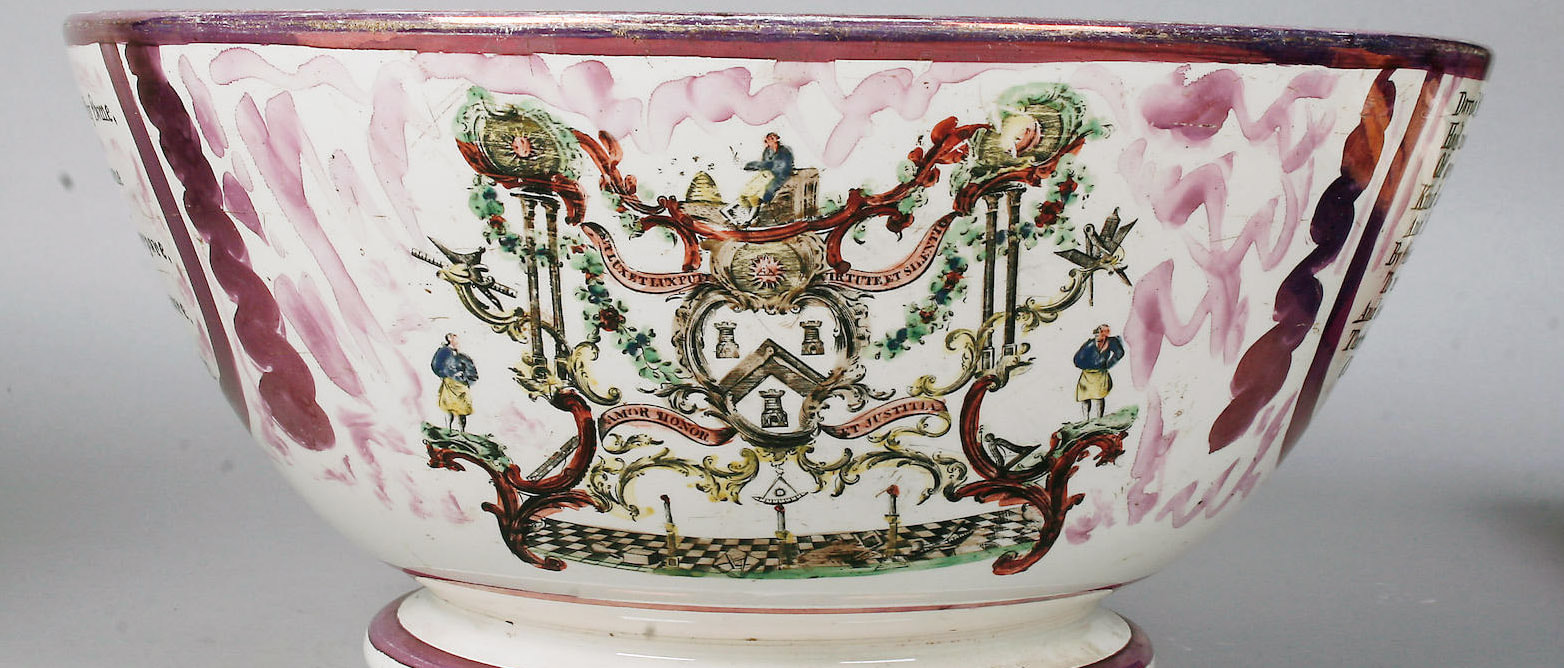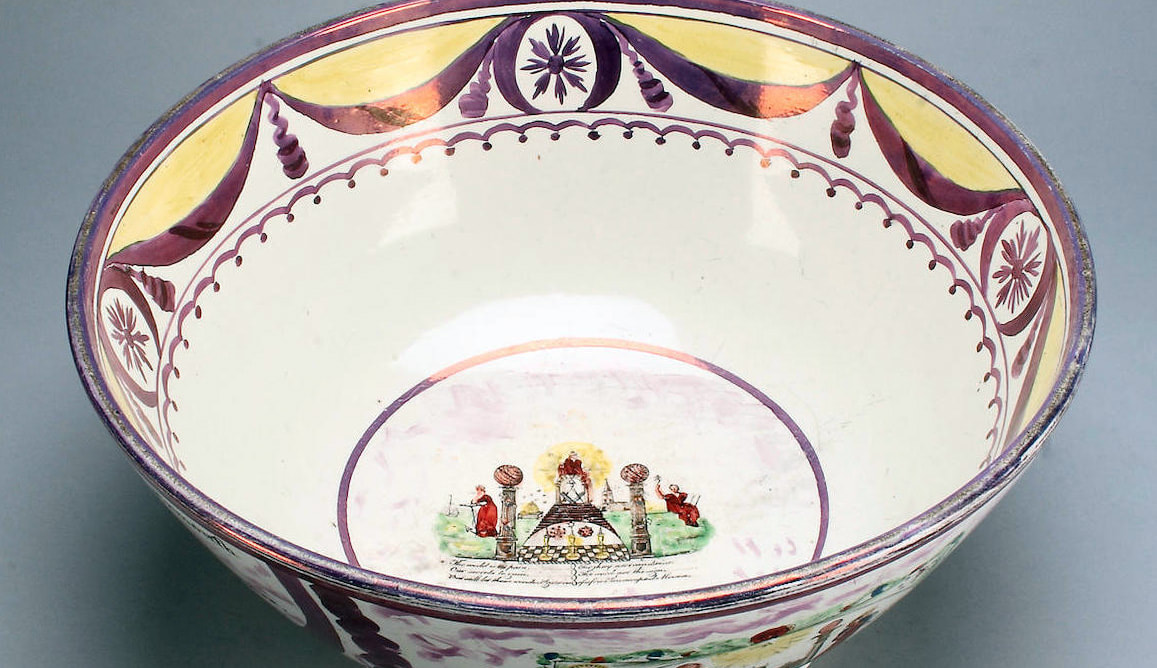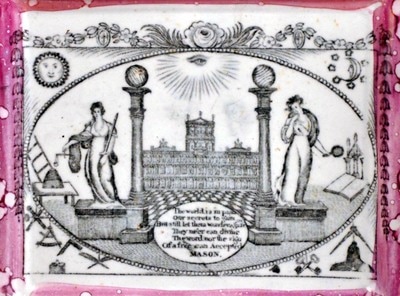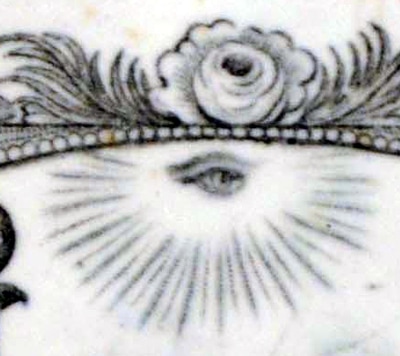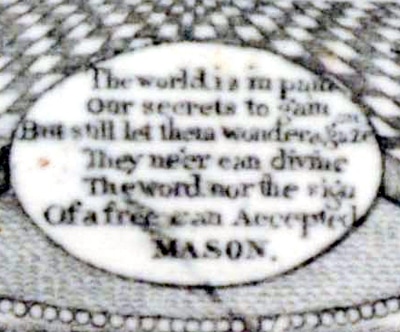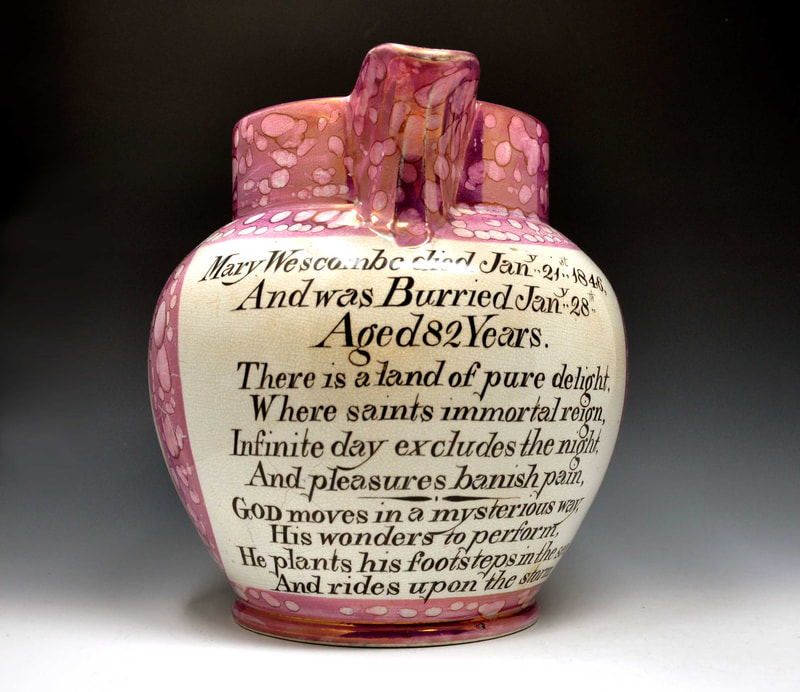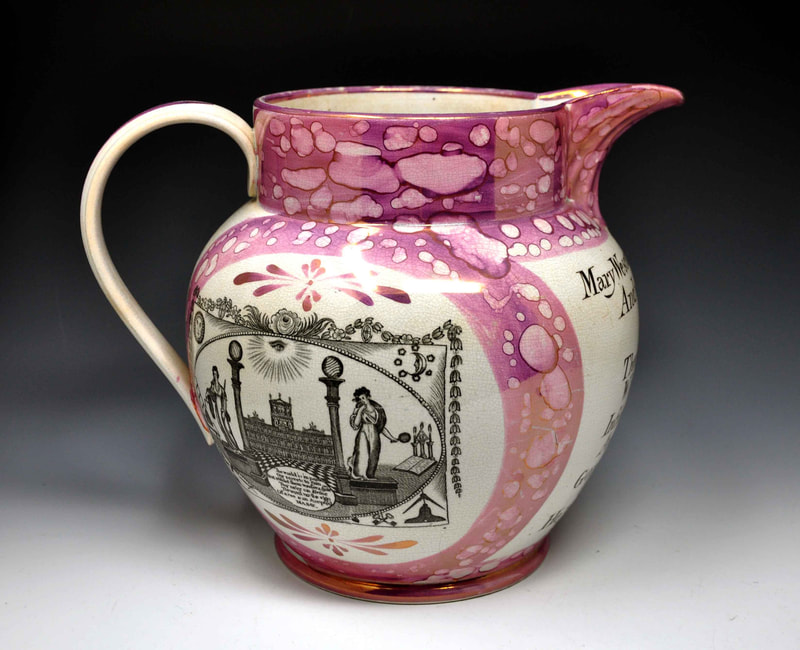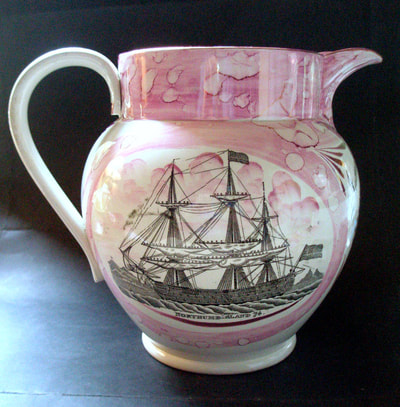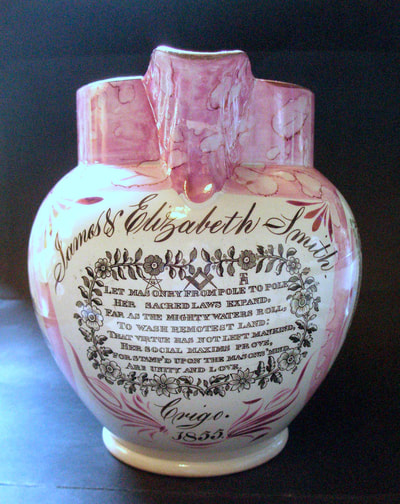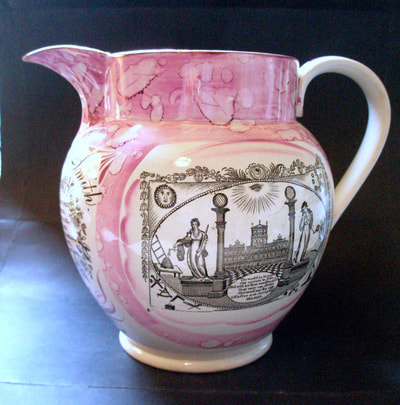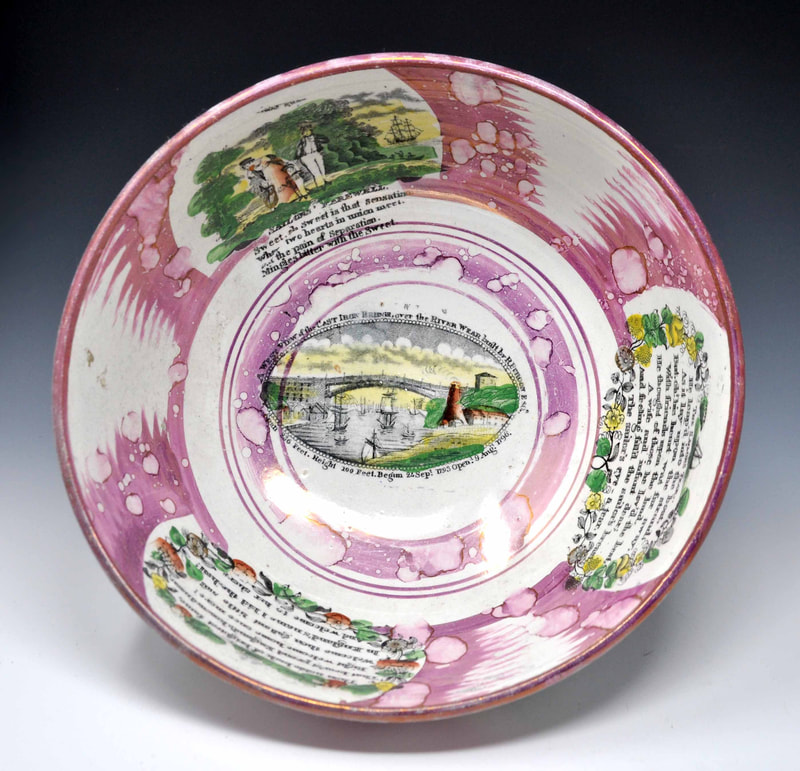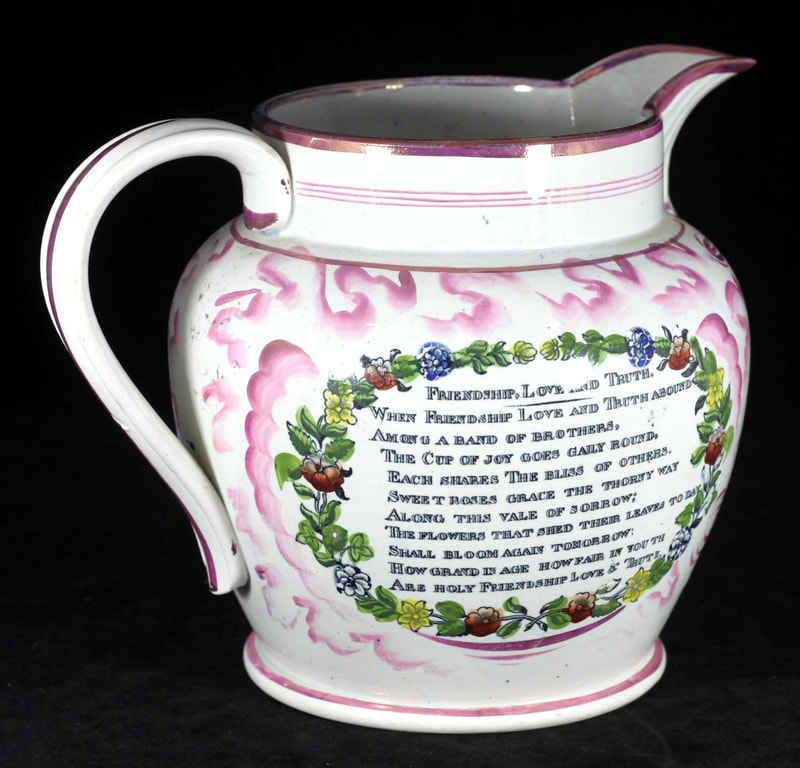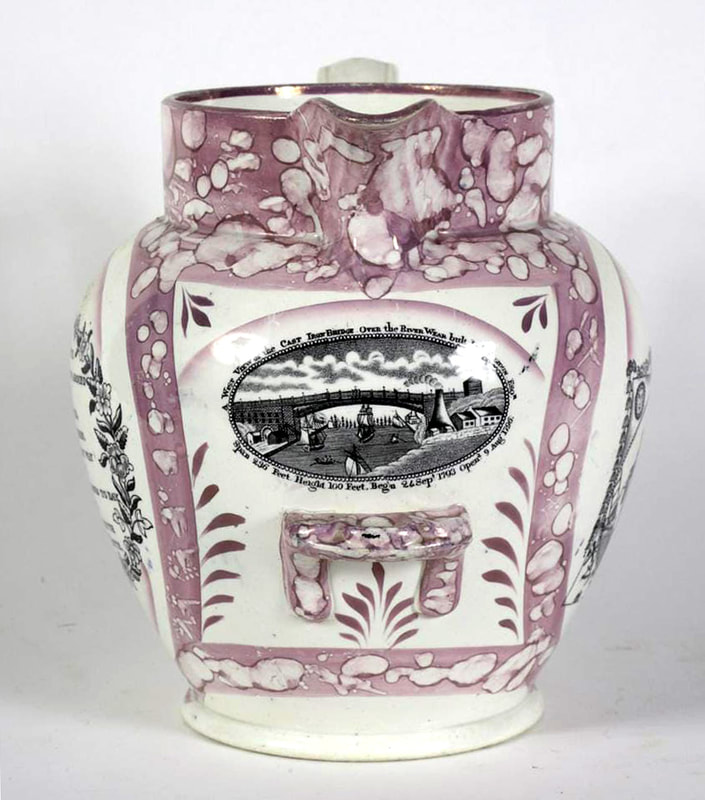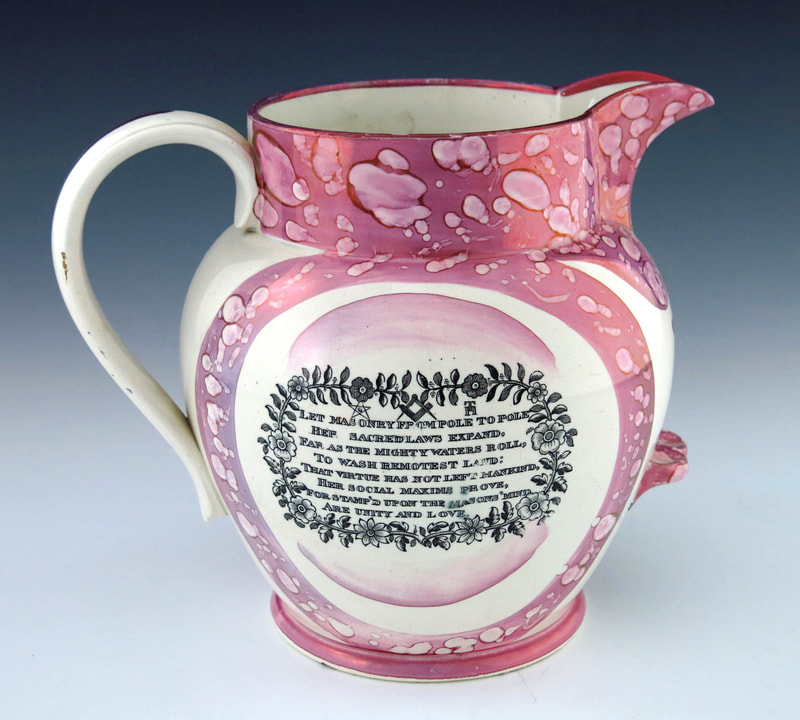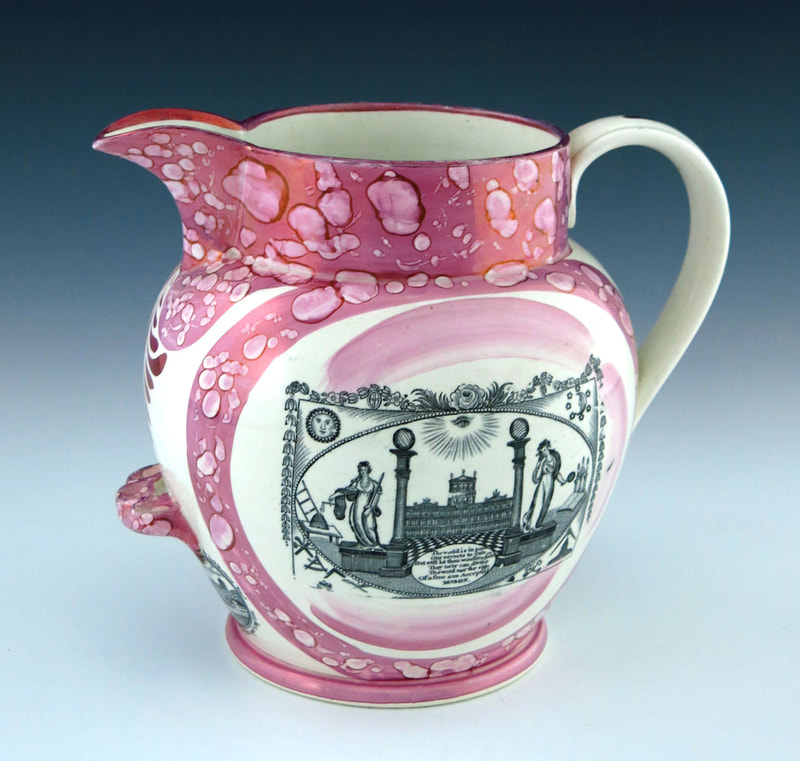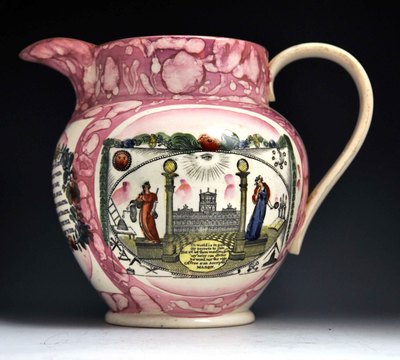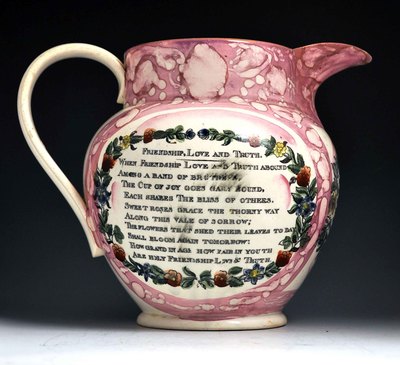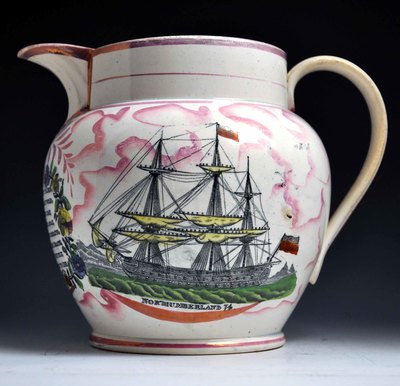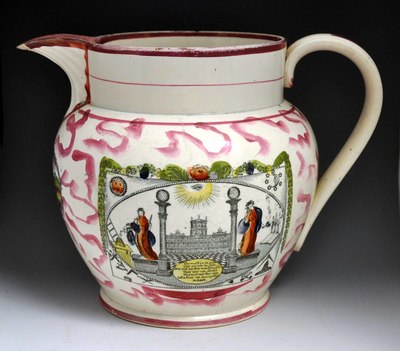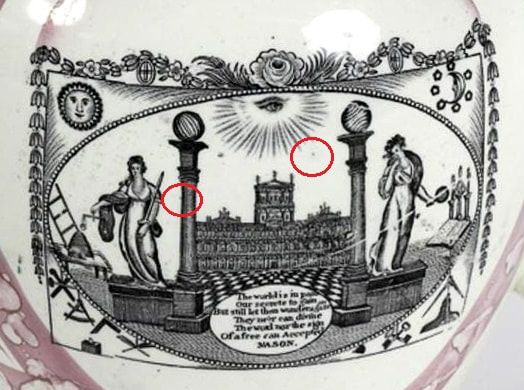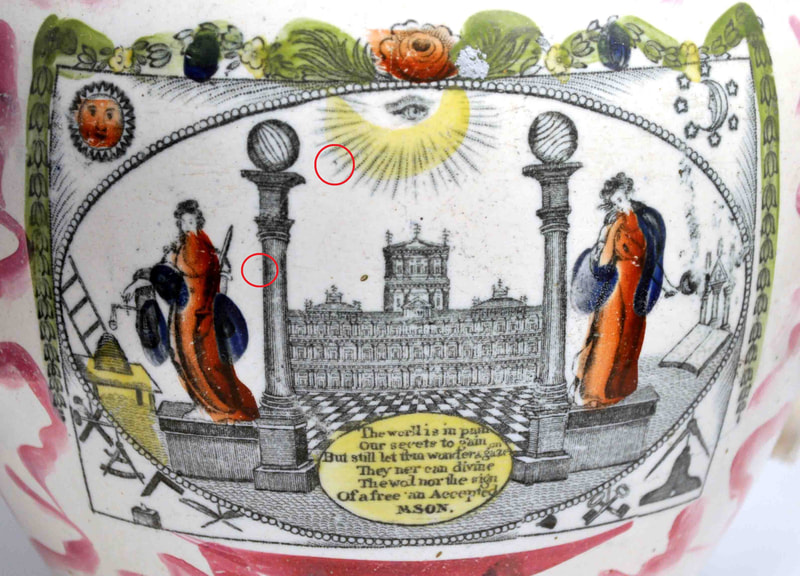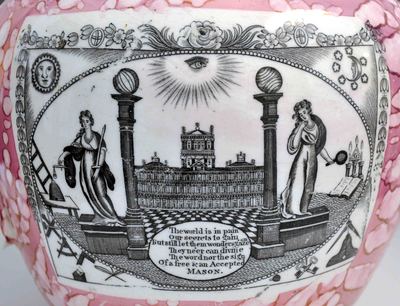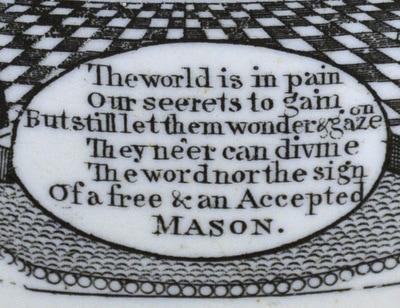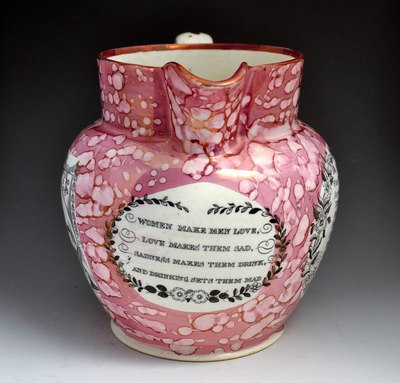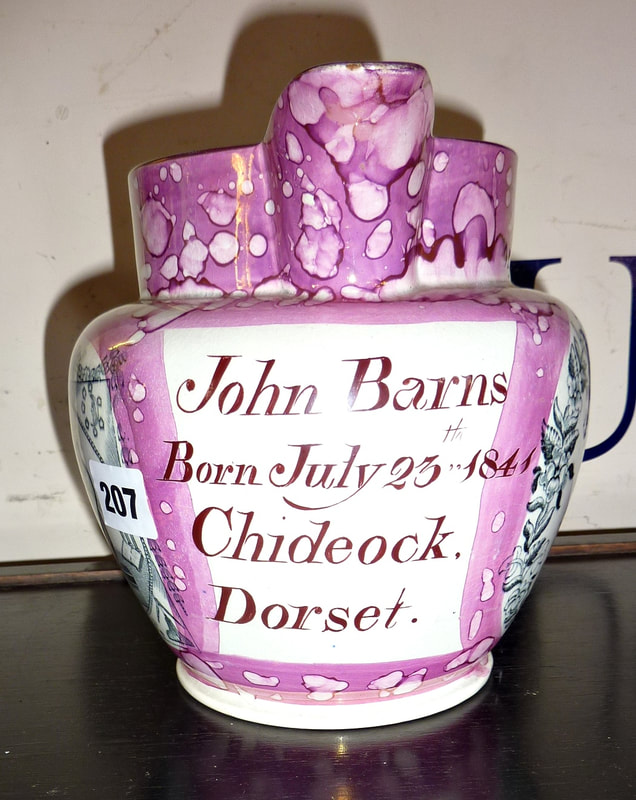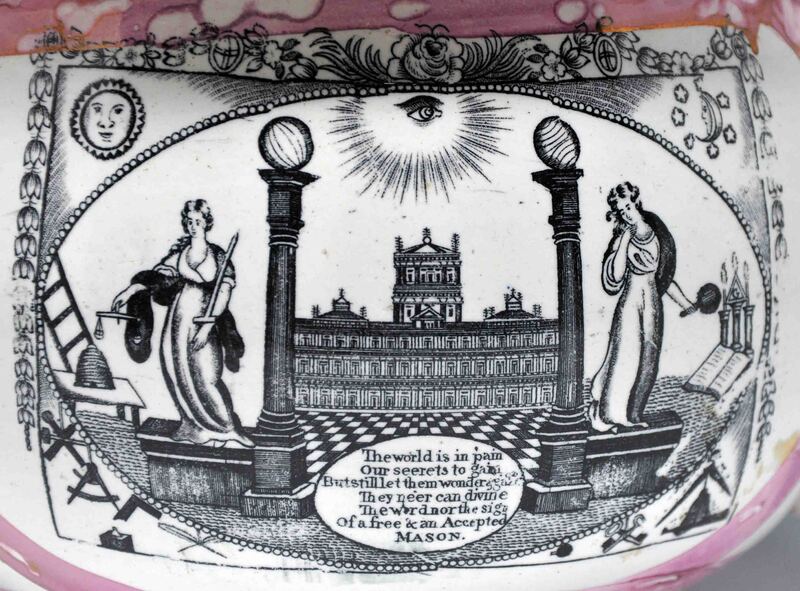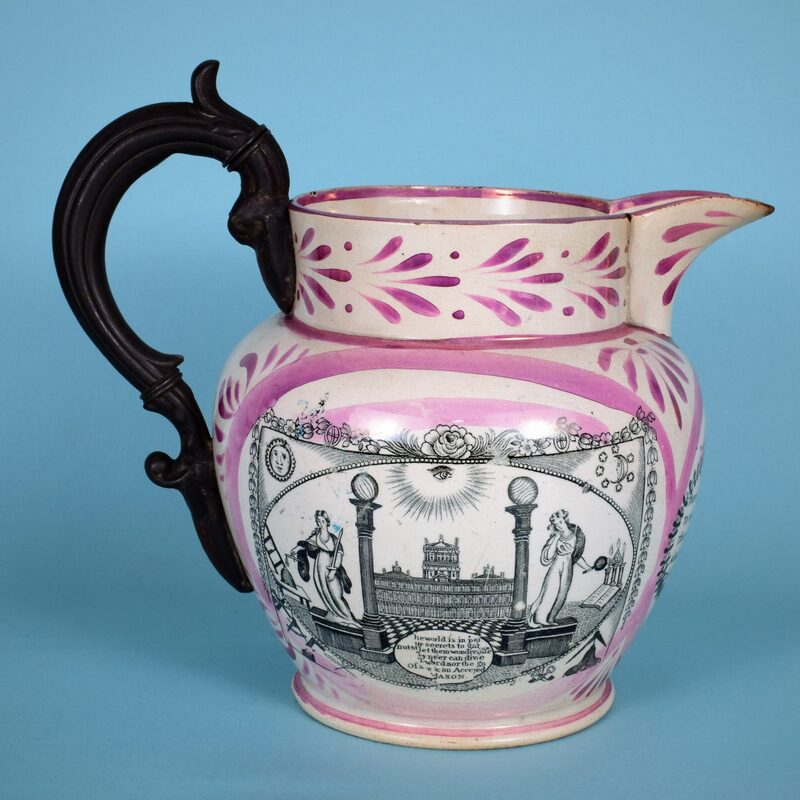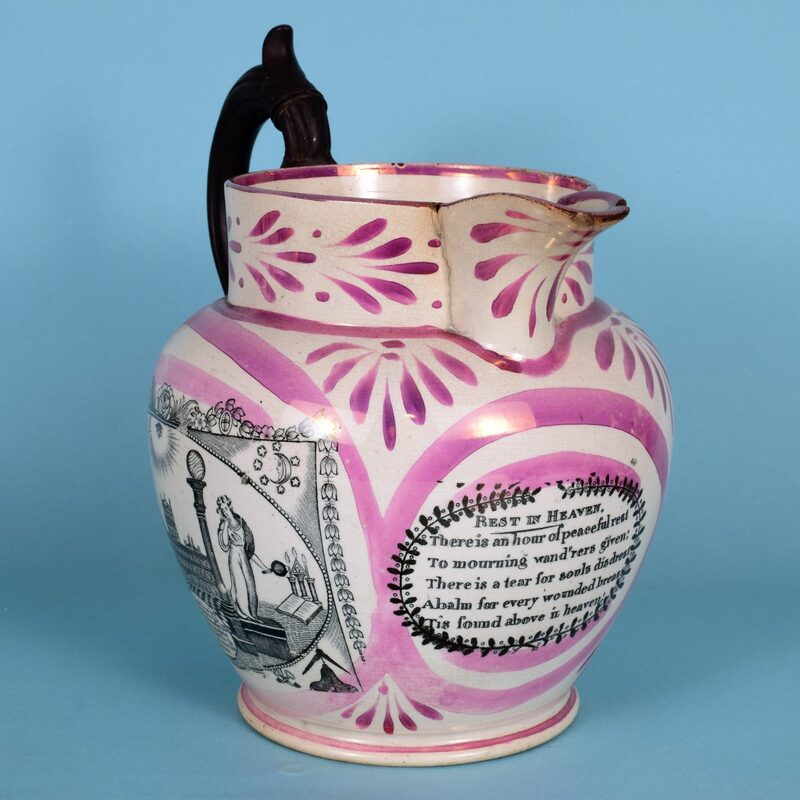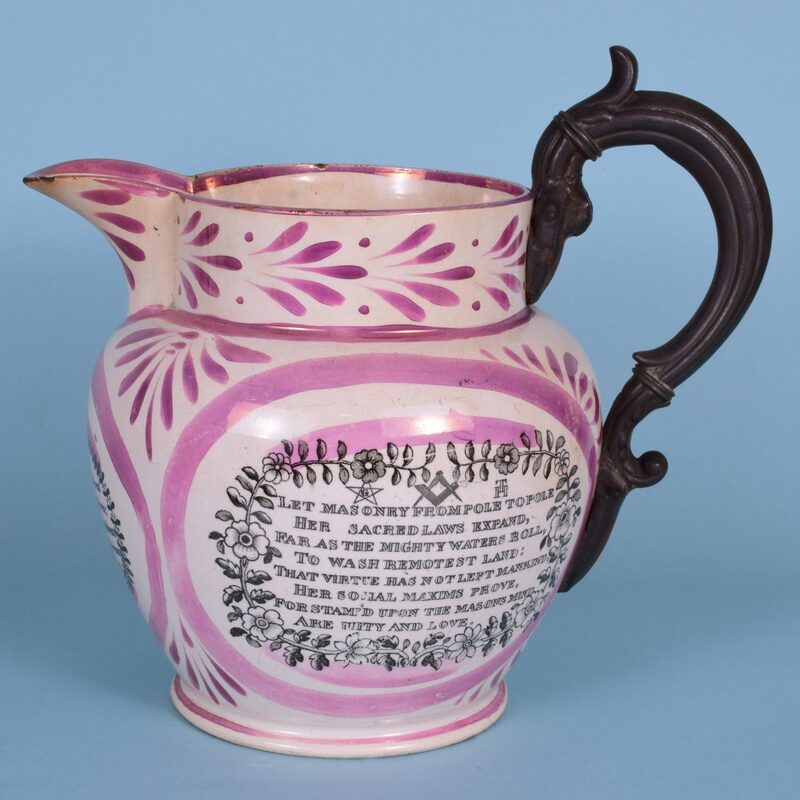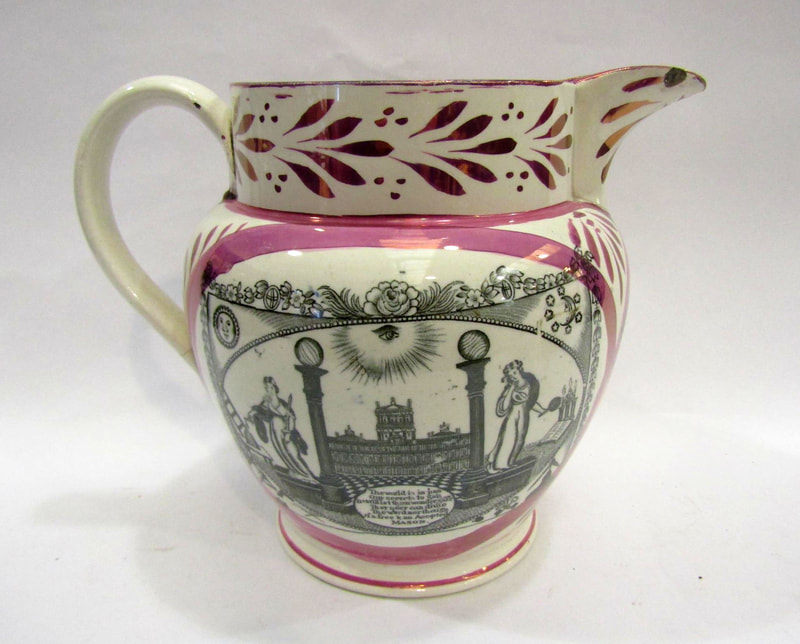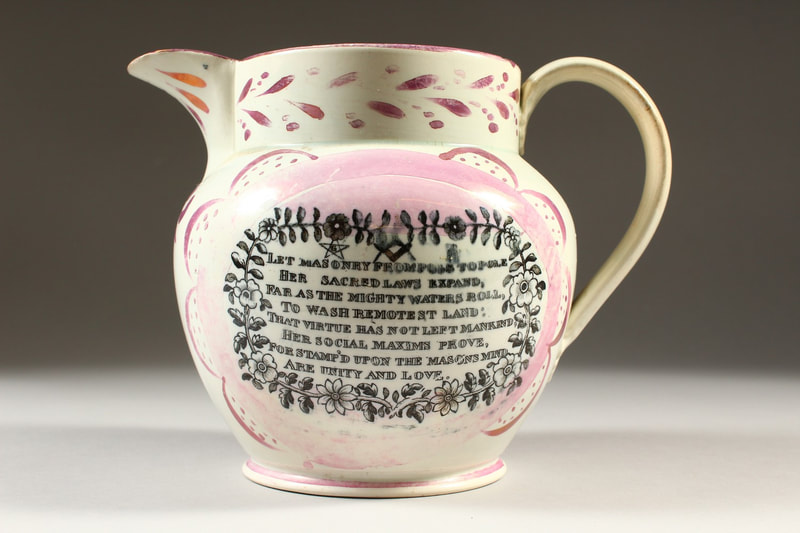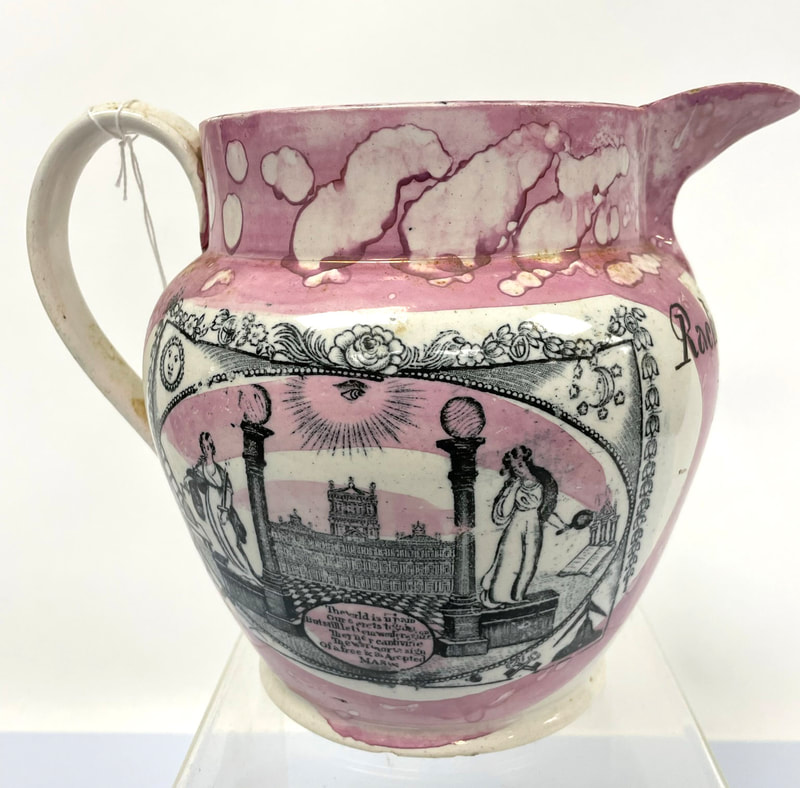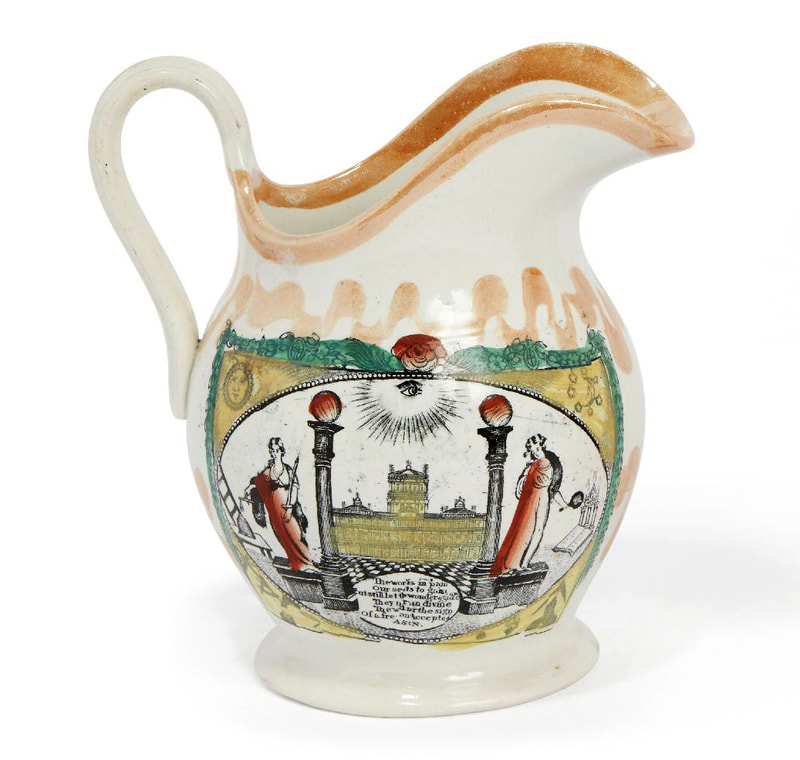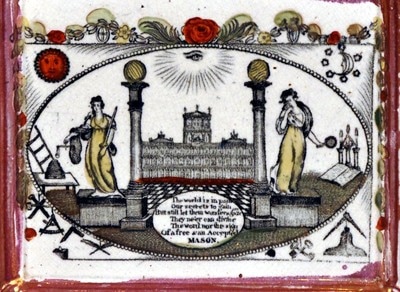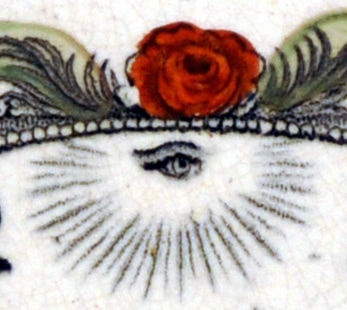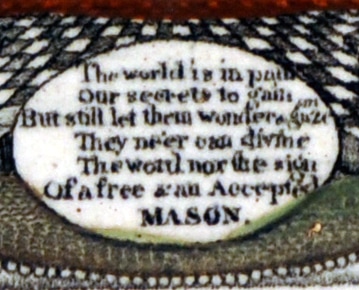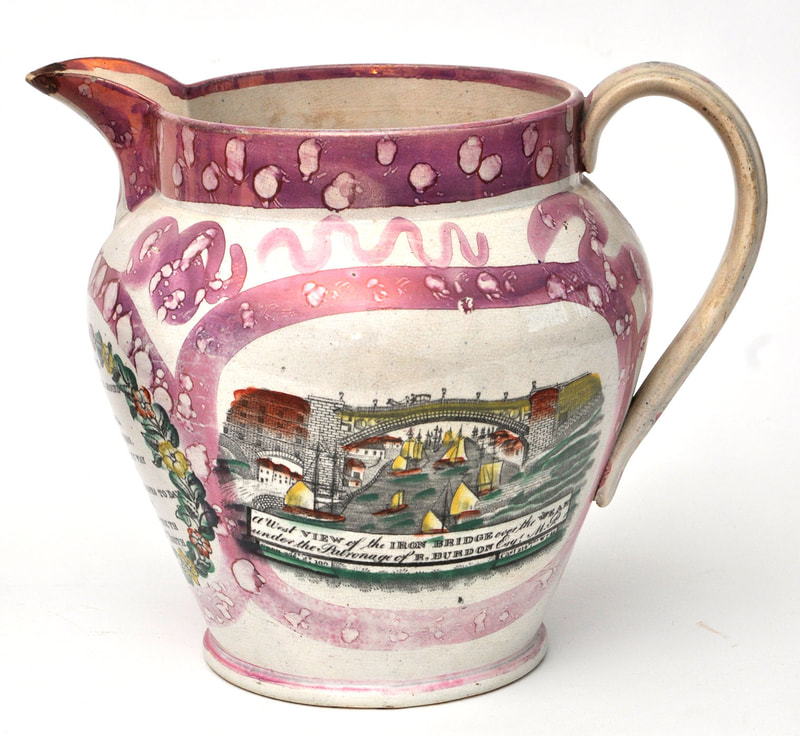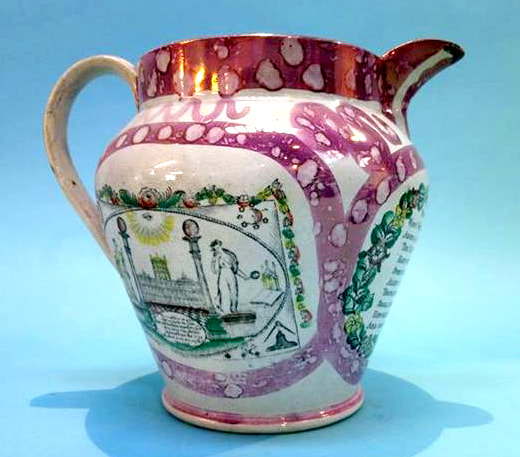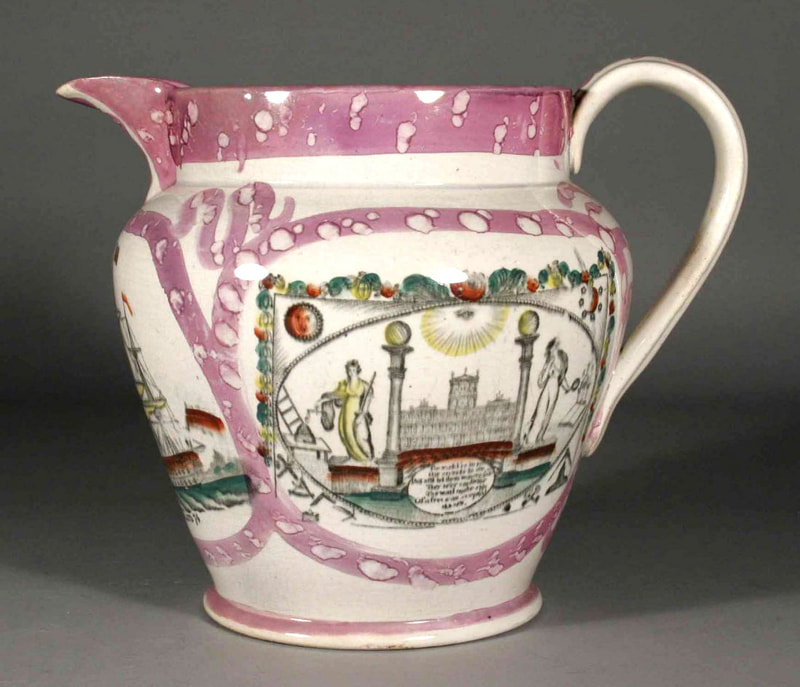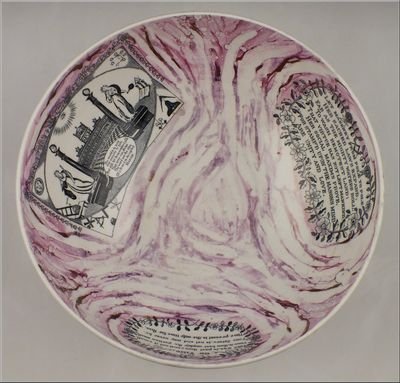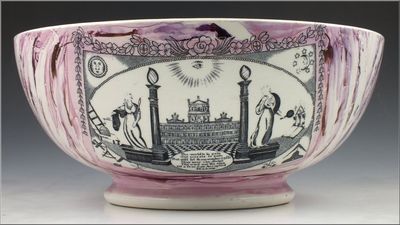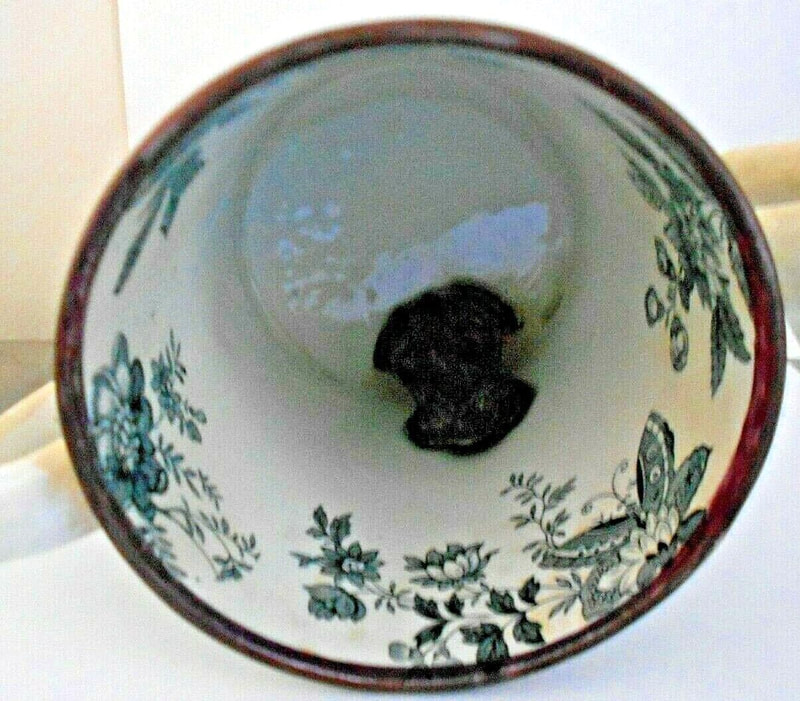Masonry – Sunderland
J Phillips & Co, Sunderland Pottery
This early version of the transfer that appears on early creamware jugs has a printed factory mark 'J. PHILLIPS & Co. Sunderland Pottery' below the verse at the bottom. Baker states that the John Phillips proprietorship ran from 1807 to 1812. However, J Phillips transfers also appear on items with Dixon Co transfers, well into the 1830s. I would guess this jug is 1820s. This transfer could have been used at the North Hylton site or at the Garrison Pottery. Both sites operated as the Sunderland Pottery.
A broad collared jug below. Both transfers have the printed mark 'J PHILLIPS & Co Sunderland Pottery'. This bridge view can also be found with the printed mark 'DIXON& Co'. There are mugs with very similar floral decoration in the Sunderland Museum inscribed with the date 1825.
The over enamelling of this transfer on this 'J Phillips' mug is identical to the one beneath it, from the later partnership.
Dixon, Austin & Co, Sunderland Pottery
Two mugs from the early 1820s with the printed mark 'DIXON & AUSTIN Sunderland Pottery'. Press cuttings show that the partnership ran from 1818 to 1839.
The jug below is also marked 'DIXON & AUSTIN Sunderland Pottery', and likely dates from the early 1820s.
This jug also has a transfer with the printed mark 'DIXON & Co SUNDERLAND POTTERY' (see below).
Below is a creamware jug with the same transfer with the mark 'DIXON & AUSTIN Sunderland Pottery', and lustre decoration around the collar and foot. This pattern of lustre decoration around the spout was used from the early 1820s to the late 1830s.
Below is a more familiar looking pink lustre jug and mug. Although the inscription is dated 1804, both the jug and the mug were likely made in the mid to late 1820s.
Below is another pink lustre jug with the same transfer with the mark 'DIXON & AUSTIN Sunderland Pottery'. This jug with colourful over enamels is likely later, from the 1830s.
Below, the Dixon Austin version on a large and superbly decorated bowl, with other Masonic transfers and hand-painted inscriptions, but no date.
Dixon, Phillips & Co, Garrison Pottery
This Garrison transfer from the 1840s, 50s and 60s is very similar to the Low Lights 1 version further down this page. However, there are some subtle differences as follows. Top right detail: leaf to the right of the flower (above the sun) points to the right. Bottom left detail: the rose above the eye doesn't have separate petals. Bottom centre detail: the letter 't' in the word accepted looks squeezed in.
The earliest use of this particular version of the transfer I've seen is on the jug below dated 1846.
The earliest use of this particular version of the transfer I've seen is on the jug below dated 1846.
The marriage jug below is dated 1855. The large punch bowl is c1860. The second jug has an inscription for 1859.
Two larger jugs with a handle to assist pouring.
The imprints are clearer on these jugs with brightly coloured enamels, c1860–65, and on the jug with the handle above, so it is possible the plate was re-engraved towards the end of its life. The petals of the rose in the bottom left detail are better defined.
There are small nicks and scratches that unite the objects with this transfer, suggesting the transfers came from the same copper plate.
Masonry – Tyneside
Carr & Patton (1838–1846) – Low Lights Pottery, North Shields 1
Top right detail: leaf to the right of the flower (above the sun) points upwards. Bottom left detail: the rose above the eye doesn't has separately drawn petals. Bottom centre detail: the letter 't' in the word accepted is well spaced.
This transfer is attributed to John Carr on the basis of the inscribed jugs below dated 1841 and 1842. The text is typical of items from Carr and Patton's Low Lights Pottery in North Shields.
John Carr & Co (1846–1855) – Low Lights Pottery, North Shields 1
A chamber pot with the same version of the transfer.
The elaborate lustre decoration on the jugs below is unique to North Shields. The first has a large metal handle – a glorious improvised repair by a blacksmith, and a reminder of how precious and non-disposable these items were.
John Carr & Sons (1855–1893) – Low Lights Pottery, North Shields 1
A later jug with the transfer and an inscription for 1857. French names are common on these jugs as John Carr & Sons did much trade with the Channel Islands.
A wash ewer with the transfer and typical Carr orange-lustre decoration from the mid 1860s–1870s.
John Carr & Sons (1855–1893) – Low Lights Pottery, North Shields 2
The plaques below, although attributed to Carr's Low Lights Pottery in North Shields, have the Garrison Pottery version of this transfer. The transfer plate was likely bought by Carr's in 1865 when the Garrison Pottery closed. They have the same nicks and scratches as the Dixon items above.
Below, three Carr-attributed jugs with the Dixon version of the transfer and similar enamels over the transfer as the plaque above.
Maling Pottery – 20th century reproductions
This jug is printed with a variation of the Low Lights 1 transfer. Maling made bowls and jugs with this transfer in the mid 20th century. However, they didn't always mark these items, so 'buyer beware'.
The unmarked masonic items below with distinctive marbled-lustre decoration are 20th century repros. They are unmarked but were likely also made by Maling. The loving cup has been restored which gives it a look of some age. However, lustre loving cups like this one with moulded handles are always repros.
